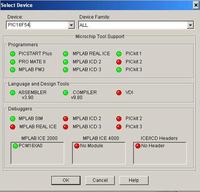Err404
Junior Member level 1
Hi.
I bought this PIC in a hurry and have found it's not very well supported.
But I'd like to get some use out of it, except I can't be sure if it's working okay.
I'm new to PICs - I bought the chip just really to test the programmer I got - a clone PicKit2 (from Piccircuit - PIC Circuit Design Expert - Complete PIC Solution) works okay.
The led on the programmer flashes as if it's communicating with the chip properly, but throws an error 'programming failed at program memory address 0x000000'. I think this because the HEX file I've given it is garbage (due to not really know what I'm doing!), but I want to make sure it's not due to faulty components, etc.
If someone can just point me to a dead simple ASM that will say toggle some ports - something I can test with a meter, then that'd be cool!
I'd rather program the device in C as I know it already, but the MPLab IDE suplied by microchip doesn't claim to support this PIC and so I've been compiling/making in MPlab and using 'piccircuit's HEX flasher to upload. Which is obviously a faff & gives no debugging potential, etc.
Anyway, in anticipation - Thanks!
I bought this PIC in a hurry and have found it's not very well supported.
But I'd like to get some use out of it, except I can't be sure if it's working okay.
I'm new to PICs - I bought the chip just really to test the programmer I got - a clone PicKit2 (from Piccircuit - PIC Circuit Design Expert - Complete PIC Solution) works okay.
The led on the programmer flashes as if it's communicating with the chip properly, but throws an error 'programming failed at program memory address 0x000000'. I think this because the HEX file I've given it is garbage (due to not really know what I'm doing!), but I want to make sure it's not due to faulty components, etc.
If someone can just point me to a dead simple ASM that will say toggle some ports - something I can test with a meter, then that'd be cool!
I'd rather program the device in C as I know it already, but the MPLab IDE suplied by microchip doesn't claim to support this PIC and so I've been compiling/making in MPlab and using 'piccircuit's HEX flasher to upload. Which is obviously a faff & gives no debugging potential, etc.
Anyway, in anticipation - Thanks!
